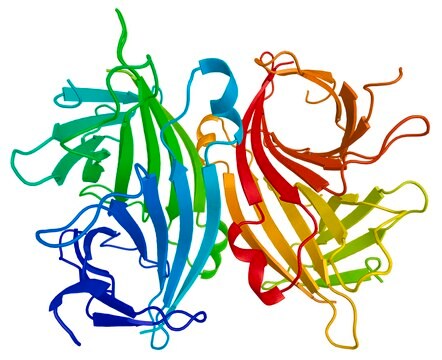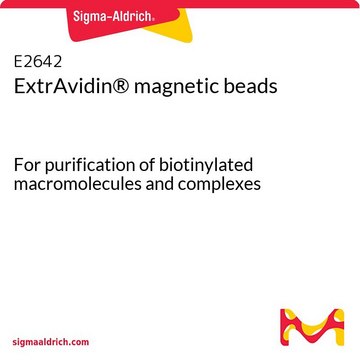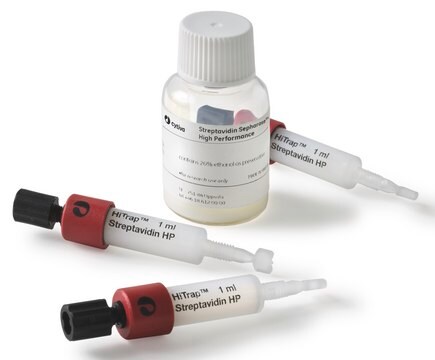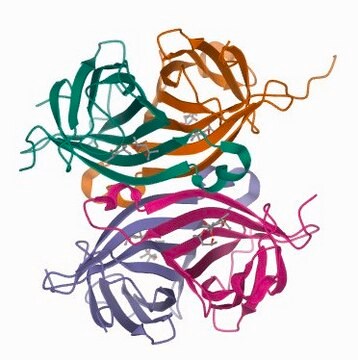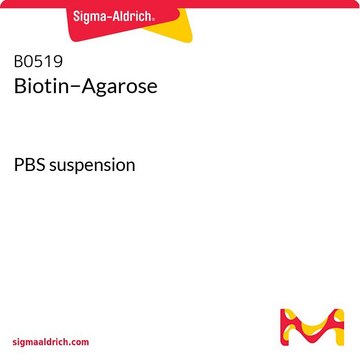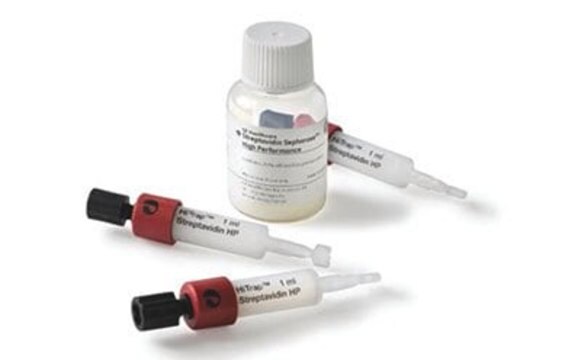E2513
ExtrAvidin®-Agarose, high binding
For purification of biotinylated macromolecules and complexes
Sinónimos:
ExtrAvidin® beads, de-glycosylated Avidin
Iniciar sesiónpara Ver la Fijación de precios por contrato y de la organización
About This Item
Código UNSPSC:
41106500
NACRES:
NA.56
Productos recomendados
formulario
aqueous suspension
suspension
Características
For purification of biotinylated macromolecules and complexes
concentración
50%
matriz
4% agarose (beaded)
activación de la matriz
cyanogen bromide
temp. de almacenamiento
2-8°C
Descripción general
ExtrAvidin® is a unique de-glycosylated Avidin modified form of an affinity purified egg white avidin. The ExtrAvidin is conjugated to cyanogen bromide-activated agarose beads.
ExtrAvidin® is a tetrameric protein containing four biotin binding sites. The Avidin-Biotin high affinity interaction (Kd=10-15M) is considered one of the strongest non-covalent interactions known in nature. The use of Avidin-Biotin complex for affinity purification was described in the first half of 1970 and since then it was successfully utilized in numerous studies and biotechnological applications.1-3 This was achieved due to the ability to chemically coupe the small Biotin molecule with different binders, without disturbing its function or structure, thus allowing unique interaction with a variety of Avidin carriers including: protein or DNA molecules, Avidin protein bound to a solid surface matrix, reporter molecules, probes or carriers,. Among the known Avidin-Biotin interaction based applications are purification, enrichment, detection, amplification and other research medical and industrial processes. In addition, the ExtrAvidin® high specificity binding to Biotin, together with the low background staining, grant it significant advantage compared to the non-modified Avidin or Streptavidin produced by Streptomyces avidinii.
ExtrAvidin® is a tetrameric protein containing four biotin binding sites. The Avidin-Biotin high affinity interaction (Kd=10-15M) is considered one of the strongest non-covalent interactions known in nature. The use of Avidin-Biotin complex for affinity purification was described in the first half of 1970 and since then it was successfully utilized in numerous studies and biotechnological applications.1-3 This was achieved due to the ability to chemically coupe the small Biotin molecule with different binders, without disturbing its function or structure, thus allowing unique interaction with a variety of Avidin carriers including: protein or DNA molecules, Avidin protein bound to a solid surface matrix, reporter molecules, probes or carriers,. Among the known Avidin-Biotin interaction based applications are purification, enrichment, detection, amplification and other research medical and industrial processes. In addition, the ExtrAvidin® high specificity binding to Biotin, together with the low background staining, grant it significant advantage compared to the non-modified Avidin or Streptavidin produced by Streptomyces avidinii.
Aplicación
ExtrAvidin®-Agarose provides high affinity with high specificity binding to Biotin (also known as vitamin B7) including biotinylated proteins and biotin-tagged fusion proteins. The product may be used in various immunological techniques, including Immunoprecipitation and Immunoaffinity purification.
Precaución
DO NOT FREEZE
Forma física
ExtrAvidin®-Agarose is provided as suspension at a 1:1 ratio, in 0.01 M phosphate buffered saline, pH 7.4, containing 15 mM sodium azide as a preservative.
Información legal
ExtrAvidin is a registered trademark of Merck KGaA, Darmstadt, Germany
Cláusula de descargo de responsabilidad
This product is for research use only, not for drug, household, or other uses. Please consult the Material Safety Data Sheet for information regarding hazards and safe handling practices.
Código de clase de almacenamiento
10 - Combustible liquids
Clase de riesgo para el agua (WGK)
WGK 3
Punto de inflamabilidad (°F)
Not applicable
Punto de inflamabilidad (°C)
Not applicable
Certificados de análisis (COA)
Busque Certificados de análisis (COA) introduciendo el número de lote del producto. Los números de lote se encuentran en la etiqueta del producto después de las palabras «Lot» o «Batch»
¿Ya tiene este producto?
Encuentre la documentación para los productos que ha comprado recientemente en la Biblioteca de documentos.
Los clientes también vieron
Samantha Ames et al.
Oncogene, 39(8), 1710-1723 (2019-11-15)
Tumor cells rely on glycolysis to meet their elevated demand for energy. Thereby they produce significant amounts of lactate and protons, which are exported via monocarboxylate transporters (MCTs), supporting the formation of an acidic microenvironment. The present study demonstrates that
Nuestro equipo de científicos tiene experiencia en todas las áreas de investigación: Ciencias de la vida, Ciencia de los materiales, Síntesis química, Cromatografía, Analítica y muchas otras.
Póngase en contacto con el Servicio técnico

